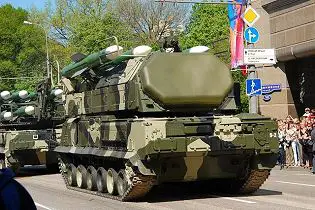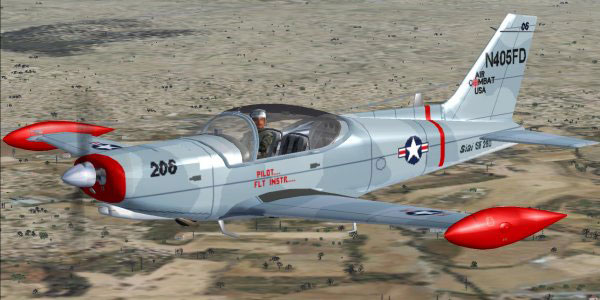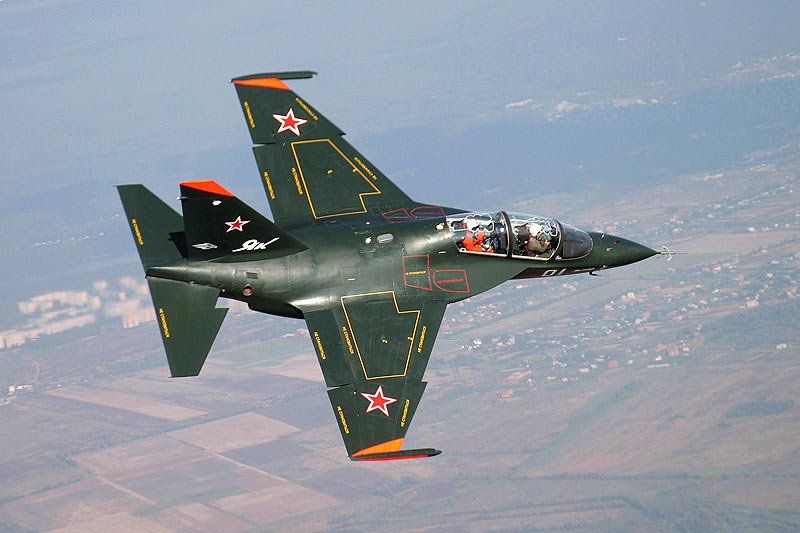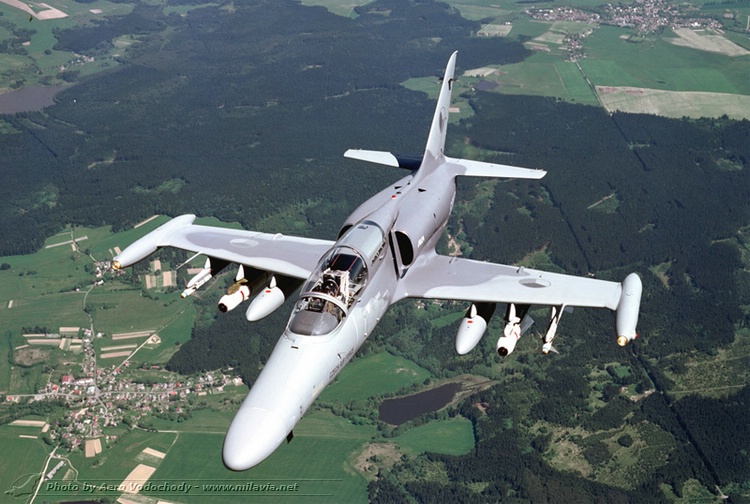The Ka-50 Black Shark helicopter (Russian: Чёрная акула; Chornaya Akula, NATO reporting name: Hokum A) is a single-seat attack helicopter for destroying armored vehicles, slow-speed air targets and manpower on the battlefield.Coaxial Ka-50 helicopter has two three-blade rotors of 14.5-m diameter each. The polymeric composite blade is attached to the hub by a torsion bar. The airframe features perfect aerodynamic outlines, mid-set stub wing, retractable three-leg landing gear and empennage of a fixed-wing aircraft type. The pilot cockpit is fully armored.
Here goes the code of the element you want to show
Mil Mi-28 Havoc Combat Helicopter, Russia
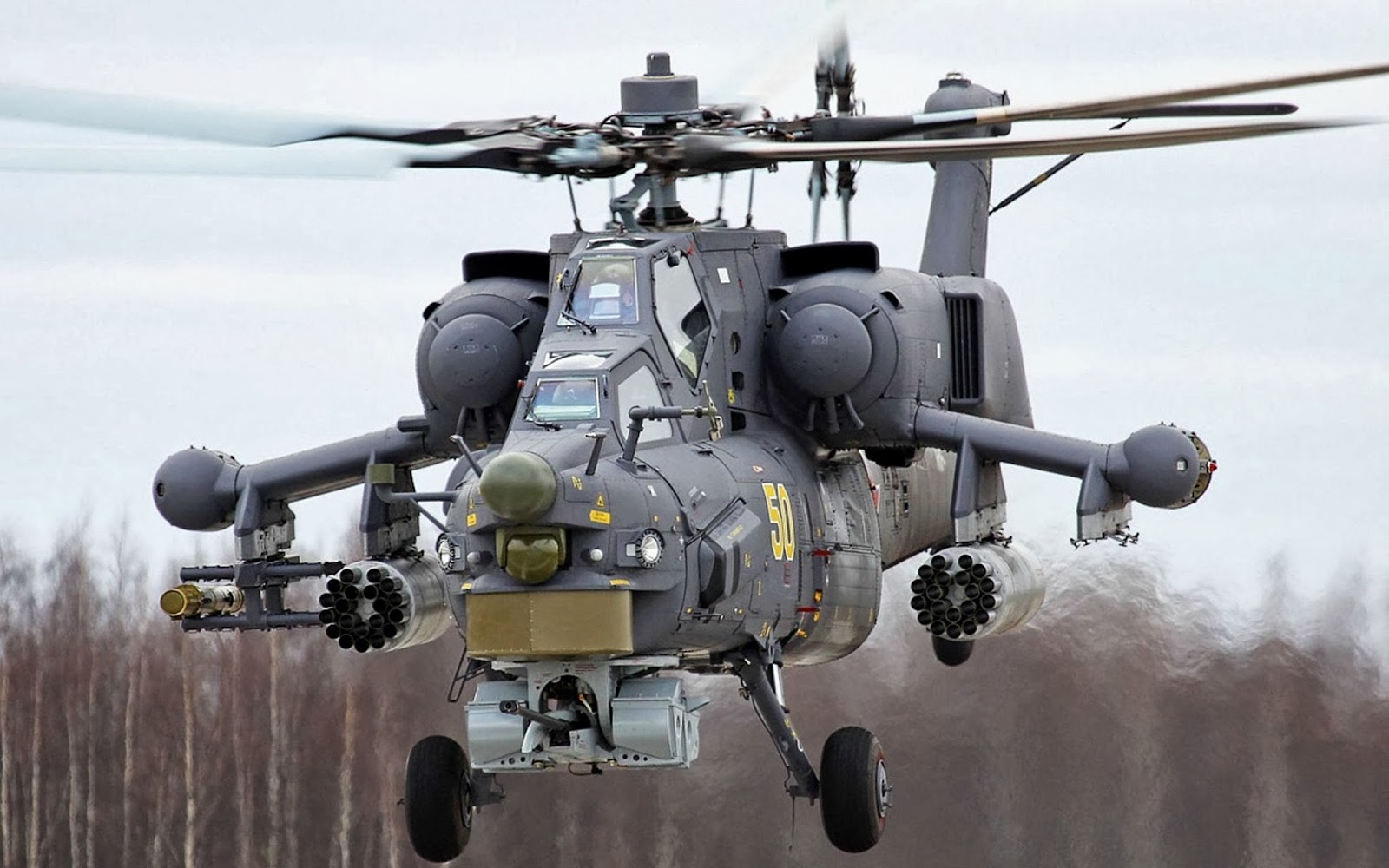
The Mil Mi-28 (NATO reporting name "Havoc") is a Russian all-weather, day-night, military tandem, two-seat anti-armor attack helicopter. It is a dedicated attack helicopter with no intended secondary transport capability, better optimized than the Mil Mi-24 gunship for the role. It carries a single gun in an undernose barbette, plus external loads carried on pylons beneath stub wings.
First flown in November 1982, and designed to fulfil the same role as the American AH-64 Apache which it generally resembles, the agile Mi-28 'Havoc' military helicopter was scheduled to enter full service with the CIS forces in 1992, but lost out to the Kamov Ka-50. The three prototypes had a conventional three-bladed tail rotor but this has since been replaced by a 'delta 3' x-configured rotor comprising two independent two-bladed propellers mounted on the same shaft.
Tupolev Tu-160 Strategic Bomber, Russia
The Tupolev Tu-160 Beliy Lebed (or White Swan,Russian: Туполев Ту-160, NATO reporting name: Blackjack) is a supersonic, variable-sweep wing heavy strategic bomber designed by the Tupolev Design Bureau and engineering complex joint stock company of Moscow and the Kazan-Gorbunov Aircraft Production Association in Tatarstan from 1980 to 1992.
The maiden flight of the bomber was completed in December 1981 and it entered service in April 1987.
Buk-M2E Air Defence Missile System, Russia
The Buk-M2E (NATO name SA-17 Grizzly) is a Russian made mobile medium-range surface-to-air missile (SAM) system designed to defend field troops and logistical installations against air threats. SA-17 Grizzly is an upgraded version of the proven Buk-M1 mobile air defense system and retains its main features. It defeats strategic and tactical aircraft, tactical ballistic missiles, cruise missiles, air-launched missiles, guided aerial bombs and helicopters, including hovering rotorcraft, in the presence of heavy electronic countermeasures and under intense enemy fire. Moreover, it can be used against sea-surface and ground targets. The Buk-M2E SAM system includes combat elements, such as atarget-acquisition radar, a battle management station, self-propelled firing vehicles, an illumination and guidance radar, loader-launcher vehicles, surface-to-air guided missiles, as well as maintenance and repair facilities. The combat elements can be mounted either on tracked or wheeled chassis. Wheeled trucks carry the maintenance facilities. The Buk-M2 can engage a wide variety of targets from aircraft to missiles flying at an altitude of between 10 and 24,000 m out a maximum range of 50 km in given conditions. The SA-17 Grizzly can engage simultaneous of up to 24 targets flying from any direction.
Iron Dome Air Defence Missile System, Israel
The Iron Dome is an effective and innovative mobile defense solution for countering short range rockets and 155 mm artillery shell threats with ranges of up to 70 km in all weather conditions, including low clouds, rain, dust storms or fog. The Iron Dome is developed by the Israeli Defence Company Rafael. Development of Iron Dome began in January 2008, and is virtually complete after just two and a half years. The system uses a unique interceptor with a special warhead that detonates any target in the air within seconds. The Iron dome is a cost effective system that can handle multiple threats simultaneously and efficiently. The Iron Dome system has been selected by the Israeli Defense Ministry as the best system offering the most comprehensive defense solution against a wide range of threats in a relatively short development cycle and at low cost. The Iron Dome System, which is expected to provide defense to residents of Israel's South against rockets launched from the Gaza Strip, is entering into the final stages of performance testing and was even presented this week for the first time in an exhibition of technological weapons which was held at the Rabin military base. The Iron Dome system became operational in early 2011, initially deployed at air force bases in southern Israel. It will be set up in other areas, such as the town of Sderot, during significant escalations along the Gaza border.
SF-260 Light Trainer / Attack Aircraft, Italy
The SF-260 is a two-seat light trainer / attack aircraft marketed as an aerobatics and military trainer. It was designed by Stelio Frati, originally for Aviamilano, which flew the first prototype of it (then designated F.260) on July 15, 1964. Actual production was undertaken when SIAI Marchetti purchased the design soon thereafter and continued with this firm until the company was bought by Aermacchi in 1997. It is an advanced trainer aircraft currently used by civil professional flying schools. About 880 aircraft are currently operational worldwide.
MiG-AT Advanced Flight and Combat Trainer Aircraft, Russia
The MiG-AT advanced flight and combat trainer aircraft is a Russian trainer aircraft that first flew in 1996, designed to replace Aero L-29 and L-39 for the Russian Air Force. The MiG-AT is the first joint aircraft development programme between Russia and France and the first military collaborative project between Russia and the West to reach first flight.Besides the Russian Air Force and Air Defense Forces, Mikoyan sought to export the trainer to India, South Africa, Greece, France and Commonwealth of Independent States such as such Kazakhstan and Uzbekistan.
JL-9 (JianLian-9 ) Trainer / Light Attack Aircraft, China
ianLian-9 (JL-9) also known as the FTC-2000 Mountain Eagle (Shanying) is an advance trainer or light attack aircraft designed and manufactured by the Guizhou Aircraft Industry Corporation (GAIC) of China. The aircraft was designed for the People's Liberation Army Air Force (PLAAF) and the People's Liberation Army Naval Air Force (PLANAF).
Its export version is designated as FTC-2000 (Fighter Trainer-2000) Mountain Eagle (Shanying). The JL-9 was derived from its forerunner, the JJ-7 jet trainer.
Alenia Aermacchi M-346 Master,Italy
The Alenia Aermacchi M-346 Master is a military transonic trainer aircraft. The aircraft is a development of the YAK/AEM-130, a joint programme with Yakolev Design Bureau and Sokol Manufacturing Plant of Russia. In July 2000, Alenia Aermacchi announced that it would cancel the joint project and develop the aircraft alone, as the M-346.
Aero L159 Advanced Light Combat Aircraft (ALCA), Czech Republic
The Aero L-159 ALCA (Advanced Light Combat Aircraft) is a Czech-built multi-role combat aircraft. It is in service with the Czech Air Force. It is derived from the Aero L-59 Super Albatros.Developed by Aero Vodochody to meet the Czech Air Force operational requirements for a light multi-role combat aircraft. The aircraft was developed in the single-seat L159A and two-seat L159B versions.
KAI T-50 Golden Eagle,South Korea
The KAI T-50 Golden Eagle,formerly known as the KTX-2, jet trainer and light attack aircraft is a family of South Korean supersonic advanced trainers and multirole light fighters, developed by Korea Aerospace Industries (KAI) with the American aerospace company Lockheed Martin. The T-50 is South Korea's first indigenous supersonic aircraft and one of the world's few supersonic trainers.
Crotale Short Range Air Defence System, France
The Crotale EDIR (Ecartométrie Différentielle InfraRouge, "InfraRed Differential Ecartometry") is an all-weather short-range anti-air missile, which can be used to intercept low-flight anti-ship missiles and aircraft.The origins of this air defense system lie in South African order. In 1964 South Africa ordered Thomson-Houston (later Thomson-CSF and now Thales) to develop a point defense system. Development was mostly funded by South Africa, and partially by the French government.Developed by Thales Air Defense (formerly Thomson-CSF Airsys) based at Bagneux in France.
These systems were delivered to South Africa between 1971 and 1973. It was locally named the Cactus. Soon after the French air force ordered this system for airfield defense, naming the system Crotale. It entered service in 1972. By 1978 a total of 20 batteries were delivered.
AW129 Multi-Role Combat Helicopter, Italy
The AW129 multirole combat helicopter is the latest variant of the A129 Mangusta (Mongoose) helicopter in service with the Italian Army. It is manufactured by AgustaWestland, a joint venture company, which was originally formed by Finmeccanica of Italy and GKN of the UK, but is now solely owned by Finmeccanica.
Edwards Air Force Base, United States of America
Edwards Air Force Base (AFB) (IATA: EDW, ICAO: KEDW, FAA LID: EDW) is a United States Air Force installation in southern California, located approximately 22 miles (35 km) northeast of Lancaster and 15 miles (24 km) east of Rosamond.Built on a 301,000-acre (470-square-mile) site, it is the second-largest air force base in the US and features the longest runway in the country. The base was opened in 1933. Most of the land at the base is undeveloped or semi-improved and is primarily used for flight testing.
Kings Bay Naval Submarine Base, United States of America
Naval Submarine Base Kings Bay is a base of the United States Navy located adjacent to the town of St. Marys in Camden County, Georgia, in southeastern Georgia, and not far from Jacksonville, Florida. The Submarine Base is the U.S. Atlantic Fleet's home port for U.S. Navy Fleet ballistic missile nuclear submarines armed with Trident missile nuclear weapons. This submarine base covers about 16,000 acres (6,400 hectares) of land, of which 4,000 acres (1,600 hectares) are protected wetlands.
Columbus Air Force Base, United States of America
The host unit at Columbus is the 14th Flying Training Wing (14 FTW) assigned to the Air Education and Training Command. The 14 FTW's mission is to provide specialized undergraduate pilot training for U.S. Air Force and allied officers.
Columbus AFB was established in 1941 as Air Corps Advanced Flying School, Columbus, Mississippi. The commander of the 14 FTW is Colonel John J. Nichols.
Subscribe to:
Posts (Atom)


